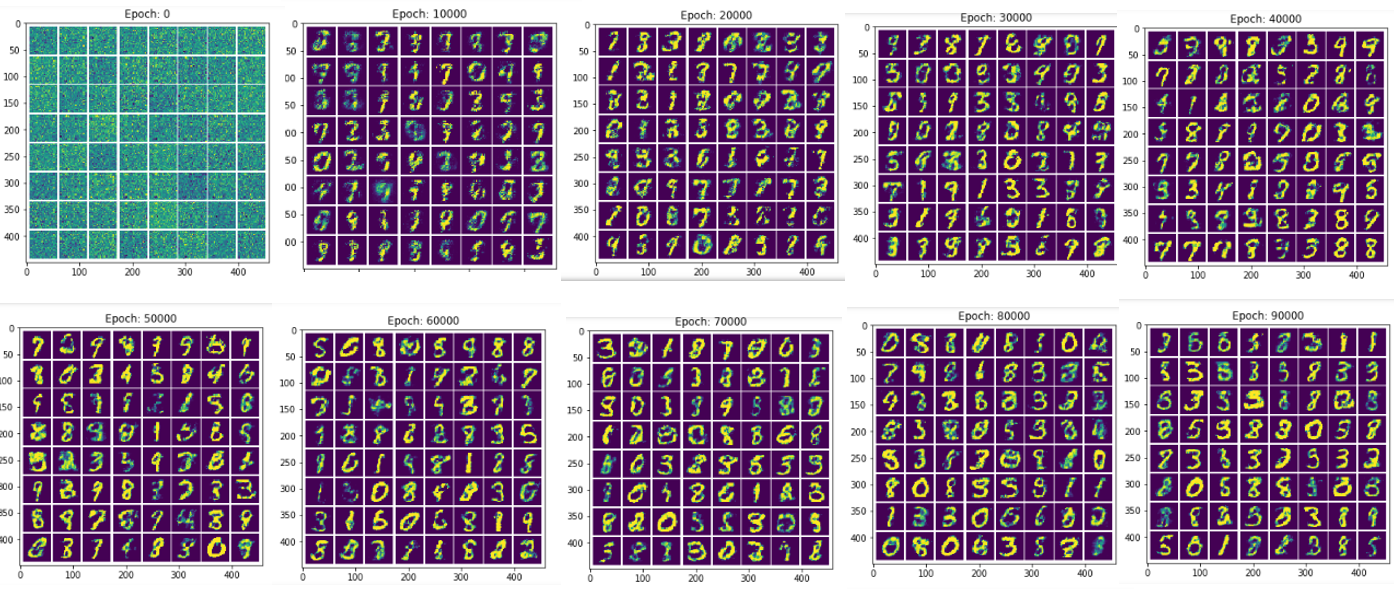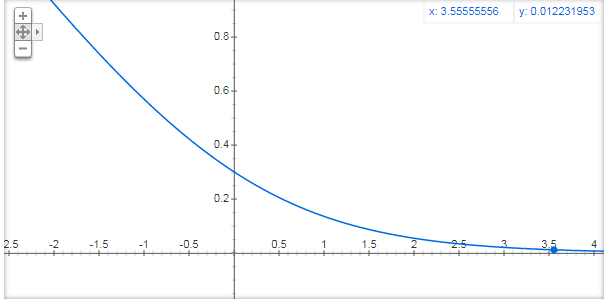Tensorflow-GAN
GAN
GAN이란 상대적 적대 신경망으로서 Generative Adversarial Network이다.
- Generative(생성적): 데이터 자체를 생성한다.
- Adversarial(적대적): 적대란 대립하거나 상반되는 관계를 뜻한다. GAN에서는 생성네트워크와 구분 네트워크간의 상반되는 목적함수로 인해 적대성이 생기게 된다.
- Network: 생성자와 구분자의 구조가 인공 신경망의 형태를 이룬다.
자세한 내용은 앞선 Post Pytorch-GAN을 참조
이번 Post에서는 Tensorflow로서 같은 작업을 해보며 성능 비교 및 결과를 확인하는 것을 목표로 한다.
GAN 구현
필요한 라이브러리 임포트
1
2
3
4
5
import tensorflow as tf
import numpy as np
import matplotlib.pyplot as plt
import matplotlib.gridspec as gridspec
import os
MNIST Dataset & Plot
MNIST데이터를 다운받고, 생성된 MNIST 이미지를 8x8 그리드 형태로 그려주는 plot 함수 정의
matplotlib.gridspec.GridSpec 사용
정식 사이트 사용 방법
이번 코드에서 사용한 방법을 알아보면
- parameter: 1 x (28x28)형태로 들어옴: samples
- figsize = (8,8): 최종적인 보여주는 suplot의 형태를 8 x 8로 지정
- plt.imshow(samples.reshape(28,28)): 1 x (28x28)형태를 image로 보기위하여 원본 image의 크기로 변환
gridspec로서 사용한 Parameter중 사용한 Parameter만 알아본다.
추가적인 자세한 Parameter는 위의 정식 사이트 이용방법에서 참조
matplotlib.gridspec.GridSpec Parameter
| Parameter | 설명 |
| nrows | Number of rows in grid |
| ncols | Number of columns in grid |
| wsapce | The amount of width reserved for space between subplots |
| hspace | The amount of height reserved for space between subplots |
1
2
3
4
5
6
7
8
9
10
11
12
13
14
15
16
# MNIST 데이터를 다운로드하고 불러옵니다.
from tensorflow.examples.tutorials.mnist import input_data
mnist = input_data.read_data_sets("/tmp/data/", one_hot=True)
# 생성된 MNIST 이미지를 8x8 Grid로 보여주는 plot 함수를 정의합니다.
def plot(samples):
fig = plt.figure(figsize=(8, 8))
gs = gridspec.GridSpec(8, 8)
gs.update(wspace=0.05, hspace=0.05)
for i, sample in enumerate(samples):
ax = plt.subplot(gs[i])
plt.axis('off')
plt.imshow(sample.reshape(28, 28))
return fig
하이퍼 파라미터 설정
- num_epoch: 반복 횟수
- batch_size: 경사하강법의 한 스템에서 사용할 배치 개수
- num_input: 입력층의 Input size
- num_latenet_variable: z의 크기이다. 즉 생성할 Noise의 차원
- num_hidden: Hidden Size크기
- learning_rate: Learning Rate
1
2
3
4
5
6
num_epoch = 100000
batch_size = 64
num_input = 28 * 28
num_latent_variable = 100 # 잠재 변수 z의 차원
num_hidden = 128
learning_rate = 0.001
PlaceHolder 설정
사용할 진짜 이미지 x 와 임의로 생성할 이미지 z(Noise)를 입력받을 변수 설정
1
2
X = tf.placeholder(tf.float32, shape=[None, num_input])
z = tf.placeholder(tf.float32, shape=[None, num_latent_variable])
생성자, 구분자 변수 선언
생성자(Generator)와 구분자(Discriminator)에 대한 변수를 각각 설정한다.
생성자(Generator)
num_latenent_variable -> num_hidden -> num_input으로서 최종적인 크기는 Input Size와 동일한 크기를 가지도록 한다.
구분자(Discriminator)
num_input -> num_hidden -> 1으로서 최종적인 크기는 1의 크기를 가지게 한다.
tf.variable_scope
변수를 공유하기 위해서 사용하는 방식이다.
예시는 아래와 같다.
1
2
3
4
5
6
7
8
9
10
11
12
13
14
def my_image_filter(input_images):
conv1_weights = tf.Variable(tf.random_normal([5, 5, 32, 32]),
name="conv1_weights")
conv1_biases = tf.Variable(tf.zeros([32]), name="conv1_biases")
conv1 = tf.nn.conv2d(input_images, conv1_weights,
strides=[1, 1, 1, 1], padding='SAME')
relu1 = tf.nn.relu(conv1 + conv1_biases)
conv2_weights = tf.Variable(tf.random_normal([5, 5, 32, 32]),
name="conv2_weights")
conv2_biases = tf.Variable(tf.zeros([32]), name="conv2_biases")
conv2 = tf.nn.conv2d(relu1, conv2_weights,
strides=[1, 1, 1, 1], padding='SAME')
return tf.nn.relu(conv2 + conv2_biases)
여러분이 쉽게 상상할 수 있듯이, 모델은 이것보다 훨씬 더 복잡하며, 여기에도 이미 4개의 다른 변수가 있습니다: conv1_weights, conv1_biases, conv2_weights, 그리고 conv2_biases. 문제는 이 모델을 다시 사용하고자 할 때 발생합니다. 2개의 다른 이미지, image1과 image2를 여러분의 이미지 필터에 적용하기를 원한다고 가정하십시오. 여러분은 같은 파라미터로 같은 필터에서 처리된 이미지가 필요합니다. my_image_filter()를 두 번 호출할 수 있지만, 이것은 두 세트의 변수를 생성합니다
First call creates one set of variables
result1 = my_image_filter(image1)
Another set is created in the second call
result2 = my_image_filter(image2)
즉 지속적인 변수 생성을 막아 메모리를 효율적으로 사용하고 변수의 범위를 지정해줄 수 있는 Tensorflow의 기능이라고 생각하면 된다.
자세한 사항은 아래 링크 참조
tensorflowkorea 사용 예시
1
2
3
4
5
6
7
8
9
10
11
12
13
14
15
with tf.variable_scope('generator'):
# 히든 레이어 파라미터
G_W1 = tf.Variable(tf.random_normal(shape=[num_latent_variable, num_hidden], stddev=5e-2))
G_b1 = tf.Variable(tf.constant(0.1, shape=[num_hidden]))
# 아웃풋 레이어 파라미터
G_W2 = tf.Variable(tf.random_normal(shape=[num_hidden, num_input], stddev=5e-2))
G_b2 = tf.Variable(tf.constant(0.1, shape=[num_input]))
with tf.variable_scope('discriminator'):
# 히든 레이어 파라미터
D_W1 = tf.Variable(tf.random_normal(shape=[num_input, num_hidden], stddev=5e-2))
D_b1 = tf.Variable(tf.constant(0.1, shape=[num_hidden]))
# 아웃풋 레이어 파라미터
D_W2 = tf.Variable(tf.random_normal(shape=[num_hidden, 1], stddev=5e-2))
D_b2 = tf.Variable(tf.constant(0.1, shape=[1]))
생성자, 구분자 생성
위에서 tf.variable_scope에서 선언한 Parameter를 활용하여 실제 Generator와 discriminator를 선언한다.
각각의 Hidden Layer는 1개 뿐이며 단순한 matmul과 sigmoid를 통하여 이루워 진다.
1
2
3
4
5
6
7
8
9
10
11
12
13
14
15
16
17
18
19
20
21
22
23
24
# Generator를 생성하는 함수를 정의합니다.
# Inputs:
# X : 인풋 Latent Variable
# Outputs:
# generated_mnist_image : 생성된 MNIST 이미지
def build_generator(X):
hidden_layer = tf.nn.relu((tf.matmul(X, G_W1) + G_b1))
output_layer = tf.matmul(hidden_layer, G_W2) + G_b2
generated_mnist_image = tf.nn.sigmoid(output_layer)
return generated_mnist_image
# Discriminator를 생성하는 함수를 정의합니다.
# Inputs:
# X : 인풋 이미지
# Outputs:
# predicted_value : Discriminator가 판단한 True(1) or Fake(0)
# logits : sigmoid를 씌우기전의 출력값
def build_discriminator(X):
hidden_layer = tf.nn.relu((tf.matmul(X, D_W1) + D_b1))
logits = tf.matmul(hidden_layer, D_W2) + D_b2
predicted_value = tf.nn.sigmoid(logits)
return predicted_value, logits
D,G 생성
GAN설명에서의 D,G를 정의하는 과정이다.
- D(x): Data를 실제 데이터는 1, 생성 데이터는 0으로 판별하는 함수
- G(x): Data를 생성하는 함수
- x: 실제 데이터
- z: Noise
위의 최종적인 결과로서
실제 Data를 분별한 값: D_real, D_real_logits 와
생성한 Data(G(z))를 분별한 값: D_fake, D_fake_logits가 생성된다.
1
2
3
4
5
6
# 생성자(Generator)를 선언합니다.
G = build_generator(z)
# 구분자(Discriminator)를 선언합니다.
D_real, D_real_logits = build_discriminator(X) # D(x)
D_fake, D_fake_logits = build_discriminator(G) # D(G(z))
LossFunction 정의
$$ \underset{G}{min} \underset{D}{max}V(D,G)$$
$$= \mathbb{E}_{x\text{~}P_{data}(x)}[logD(x)] + \mathbb{E}_{z\text{~}P_{z}(z)}[log(1 - D(G(z)))]$$
$$\mathbb{E}: \text{기대값}$$
$$x\text{~}P_{data}(x): \text{x를 실제 data의 분포에서 샘플링}$$
$$z\text{~}P_{z}(z): \text{z를 Noise의 분포에서 샘플링}$$
구분자
$$ \underset{D}{max}V(D,G)$$
$$= \mathbb{E}_{x\text{~}P_{data}(x)}[logD(x)] + \mathbb{E}_{z\text{~}P_{z}(z)}[log(1 - D(G(z)))]$$
생성자
$$ \underset{G}{min}V(D,G)$$
$$= \mathbb{E}_{x\text{~}P_{data}(x)}[logD(x)] + \mathbb{E}_{z\text{~}P_{z}(z)}[log(1 - D(G(z)))]$$
$$=> Trainning의 시간을 줄이기 위하여 식 변경$$
$$ \underset{G}{max}V(D,G) = \mathbb{E}_{z\text{~}P_{z}(z)}[log( D(G(z)))]$$
log 함수를 적용하기 위하여 tf.nn.sigmoid_cross_entropy_with_logits 사용
tf.nn.sigmoid_cross_entropy_with_logits
tf.nn.sigmoid_cross_entropy_with_logits(
labels=None,
logits=None,
name=None
)
x = logits, z = labels tf.nn.sigmoid_cross_entropy_with_logits(logits = x, labels =z) = z * -log(sigmoid(x)) + (1-z) * -log(1 - sigmoid(x))
위의 식을 아래에 적용 시켜보자
1
d_loss_real = tf.reduce_mean(tf.nn.sigmoid_cross_entropy_with_logits(logits=D_real_logits, labels=tf.ones_like(D_real_logits)))
위의 코드를 식으로서 표현하게 된다면
$$d-loss-real$$
$$= mean(1 * -log(sigmoid(\text{D_real_logits})$$
$$+ (1-1) * -log(1-sigmoid(\text{D_real_logits}))))$$
$$= mean(-log(sigmoid(\text{D_real_logits})))$$
$$= mean(-log(\frac{1}{1+e^{-\text{D_real_logits}}}))$$
$$= mean(log(1+e^{-\text{D_real_logits}}))$$
최종적인 위의 식에서 간단하게 식을 \(log(1+e^{-x})\)라고 생각하고 그래프를 그려보면 다음과 같다.
위에서 tf.variable_scope로서 변수 선언을 할 때 분산값을 작게 주어서 대부분의 값은 0의 가깝게 위치하게 되고 bias를 통하여 +0.1을 하여도 그래프의 값은 0.5 이하일 것을 예측할 수 있다.
(Gradient Vanishing이나 Gradient exploding현상이 일어나지 않을 것 이다.)
1
2
3
4
5
6
7
# Discriminator의 손실 함수를 정의합니다.
d_loss_real = tf.reduce_mean(tf.nn.sigmoid_cross_entropy_with_logits(logits=D_real_logits, labels=tf.ones_like(D_real_logits))) # log(D(x))
d_loss_fake = tf.reduce_mean(tf.nn.sigmoid_cross_entropy_with_logits(logits=D_fake_logits, labels=tf.zeros_like(D_fake_logits))) # log(1-D(G(z)))
d_loss = d_loss_real + d_loss_fake # log(D(x)) + log(1-D(G(z)))
# Generator의 손실 함수를 정의합니다.
g_loss = tf.reduce_mean(tf.nn.sigmoid_cross_entropy_with_logits(logits=D_fake_logits, labels=tf.ones_like(D_fake_logits))) # log(D(G(z))
각각의 Parameter들을 List로 통합
Tensorflow tf.trainable_variable() 사용법의 사이트를 찾아가면 tf.trainable_variables() 는 다음과 같다.
Returns all variables created with trainable = True
Returns: A list of Variable objects
위의 코드를 활용하여 각각의 Trainning가능한 Parameter들을 Discriminator와 Generator에 관련된 파라미터로서 모았다.
1
2
3
tvar = tf.trainable_variables()
dvar = [var for var in tvar if 'discriminator' in var.name]
gvar = [var for var in tvar if 'generator' in var.name]
Optimizer
Discriminator와 Generator를 구별하여 각각의 Netowrk에 관련된 Parameter들을 따로 분리하여 Optimier하는 방식이다.
Optimizer는 Adam을 사용하였다.
1
2
d_train_step = tf.train.AdamOptimizer(learning_rate).minimize(d_loss, var_list=dvar)
g_train_step = tf.train.AdamOptimizer(learning_rate).minimize(g_loss, var_list=gvar)
학습 결과 저장 폴터 지정
학습 결과로 생성된 이미지를 지정할 폴더 설정
1
2
3
4
# 생성된 이미지들을 저장할 generated_output 폴더를 생성합니다.
num_img = 0
if not os.path.exists('generated_output/'):
os.makedirs('generated_output/')
Trainning 및 결과 확인
정의된 Parameter, LossFunction, Optimizer를 통하여 Trainning한다.
매 Epoch마다 HyperParameter를 Update한다.
500 Epoch마다 생성된 Image를 저장한다.
Image는 위에서 8 x 8 개수로서 Plot하기로 하였으므로 Image를 생성하는 BatchSize는 64로서 고정한다.
np.random.uniform(-1., 1., [batch_size, 100])
numpy.random.uniform(low=0.0, high=1.0, size=None)
Draw samples from a uniform distribution
1
2
3
4
5
6
7
8
9
10
11
12
13
14
15
16
17
18
19
20
21
22
23
24
25
26
27
28
29
# 그래프를 실행합니다.
with tf.Session() as sess:
# 변수들에 초기값을 할당합니다.
sess.run(tf.global_variables_initializer())
# num_epoch 횟수만큼 최적화를 수행합니다.
for i in range(num_epoch):
# MNIST 이미지를 batch_size만큼 불러옵니다.
batch_X, _ = mnist.train.next_batch(batch_size)
# Latent Variable의 인풋으로 사용할 noise를 Uniform Distribution에서 batch_size 개수만큼 샘플링합니다.
batch_noise = np.random.uniform(-1., 1., [batch_size, 100])
# 500번 반복할때마다 생성된 이미지를 저장합니다.
if i % 500 == 0:
samples = sess.run(G, feed_dict={z: np.random.uniform(-1., 1., [64, 100])})
fig = plot(samples)
plt.savefig('generated_output/%s.png' % str(num_img).zfill(3), bbox_inches='tight')
num_img += 1
plt.close(fig)
# Discriminator 최적화를 수행하고 Discriminator의 손실함수를 return합니다.
_, d_loss_print = sess.run([d_train_step, d_loss], feed_dict={X: batch_X, z: batch_noise})
# Generator 최적화를 수행하고 Generator 손실함수를 return합니다.
_, g_loss_print = sess.run([g_train_step, g_loss], feed_dict={z: batch_noise})
# 100번 반복할때마다 Discriminator의 손실함수와 Generator 손실함수를 출력합니다.
if i % 5000 == 0:
print('반복(Epoch): %d, Generator 손실함수(g_loss): %f, Discriminator 손실함수(d_loss): %f' % (i, g_loss_print, d_loss_print))
반복(Epoch): 0, Generator 손실함수(g_loss): 1.462668, Discriminator 손실함수(d_loss): 1.422923
반복(Epoch): 5000, Generator 손실함수(g_loss): 5.218184, Discriminator 손실함수(d_loss): 0.094545
...
반복(Epoch): 90000, Generator 손실함수(g_loss): 2.534064, Discriminator 손실함수(d_loss): 0.544332
반복(Epoch): 95000, Generator 손실함수(g_loss): 2.208852, Discriminator 손실함수(d_loss): 0.578487
결과 확인
1
2
3
4
5
6
7
8
9
10
11
12
13
14
15
16
17
18
19
20
from matplotlib.image import imread
path = './generated_output/'
for i in range(10):
image_name = i * 20
image_title = i * 20 * 500
if image_name == 0:
image_name = '00'+str(image_name)
elif image_name < 100:
image_name = '0'+str(image_name)
else:
image_name = str(image_name)
image_name = path + image_name + '.png'
image = imread(image_name)
plt.figure(figsize=(5,5))
plt.title('Epoch: '+str(image_title))
plt.imshow(image)
plt.show()

참조:원본코드
참조:텐서플로로 배우는 딥러닝
문제가 있거나 궁금한 점이 있으면 wjddyd66@naver.com으로 Mail을 남겨주세요.


Leave a comment